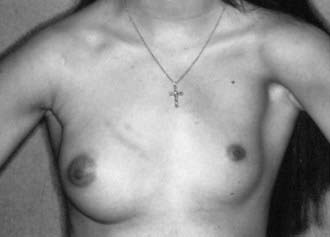Chapter 545 Breast Concerns
Abnormal Development
Precocious Puberty
Premature thelarche is usually an isolated condition but it may be the first symptom of precocious puberty. Precocious puberty occurs in 14-18% of girls with premature thelarche (Chapter 556). Serial examinations, with particular emphasis on growth velocity, secondary sex characters such as pubic hair, pigmentation of the labia or areola, or vaginal bleeding are imperative to identify precocious puberty. Unless there are associated signs of precocious puberty, the parents should be reassured and the child should be followed.
Amastia
Complete absence of the breast, or amastia, is rare and is thought to occur from lack of formation or obliteration of the milk line. Amastia is usually unilateral and can be congenital or associated with systemic disorders (e.g., malnutrition, Crohn disease) or endocrine disorders (e.g., congenital adrenal hyperplasia, gonadal dysgenesis, hypogonadotropic hypogonadism). It can be associated with anomalies of the underlying mesoderm, such as abnormal pectoralis muscles seen in Poland syndrome (aplasia of the pectoralis muscles, rib deformities, webbed fingers, and radial nerve aplasia) (Fig. 545-1). Amastia or hypomastia can also be iatrogenic, resulting from injuries sustained during thoracotomy, chest tube placement, radiotherapy, severe burns, and inappropriate biopsy of the breast bud. Treatment is surgical correction.
Polymastia and Polythelia
Supernumerary breast tissue (polymastia) and accessory nipples (polythelia) occur in approximately 1-2% of the population (Fig. 545-2). The abnormally placed tissue can be seen anywhere along the milk line but is usually noted on the chest, upper abdomen, or just inferior to the normally positioned breast. An association has been made between polythelia and anomalies of the urinary and cardiovascular system. Surgical excision of the accessory breasts or nipple is not usually needed. Resection of accessory tissue may be warranted if the patient has pain or for cosmetic reasons.
Juvenile or Virginal Hypertrophy
Spontaneous massive growth of the breasts during puberty and adolescence is thought to be the result of excessive end-organ sensitivity to gonadal hormones. The underlying cause, if any, should be determined and removed (Table 545-1). When growth is extreme it is termed macromastia or gigantomastia.
Stay updated, free articles. Join our Telegram channel

Full access? Get Clinical Tree




